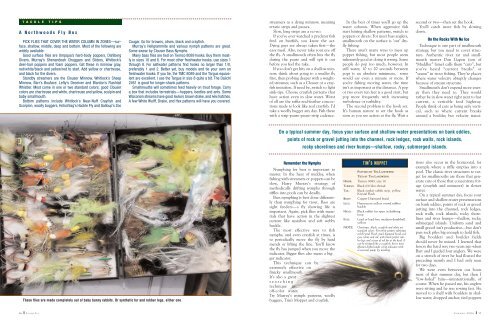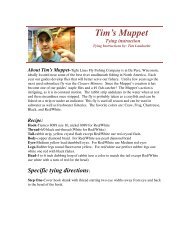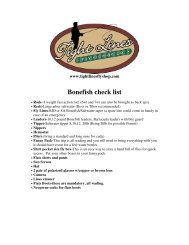30-41 Achigan - Tight Lines Fly Fishing Co.
30-41 Achigan - Tight Lines Fly Fishing Co.
30-41 Achigan - Tight Lines Fly Fishing Co.
Create successful ePaper yourself
Turn your PDF publications into a flip-book with our unique Google optimized e-Paper software.
<strong>30</strong>-<strong>41</strong> <strong>Achigan</strong> 6/19/06 7:32 PM Page 36<br />
T A C K L E T I P S<br />
A Northwoods <strong>Fly</strong> Box<br />
PICK FLIES THAT COVER THE WATER COLUMN IN ZONES—surface,<br />
shallow, middle, deep and bottom. Most of the following are<br />
widely available:<br />
Good surface flies are Umpqua’s hard-body poppers, Dahlberg<br />
Divers, Murray’s Shenandoah Chuggars and Sliders, Whitlock’s<br />
deer-hair poppers and foam poppers. Get these in minnow gray,<br />
red/white/black and yellow/red to start. Add yellow or chartreuse,<br />
and black for the divers.<br />
Standby streamers are the Clouser Minnow, Whitlock’s Sheep<br />
Minnow, Barr’s Bouface, Lefty’s Deceiver and Blanton’s Flashtail<br />
Whistler. Most come in one or two standard colors; good Clouser<br />
colors are chartreuse and white, chartreuse and yellow, sculpin and<br />
baby smallmouth.<br />
Bottom patterns include Whitlock’s Near-Nuff Crayfish and<br />
Scorpion, woolly buggers, Holschlag’s Hackle <strong>Fly</strong> and Galloup’s Zoo<br />
<strong>Co</strong>ugar. Go for browns, olives, black and crayfish.<br />
Murray’s Hellgrammite and various nymph patterns are great.<br />
Some swear by Clouser Bass Nymphs.<br />
Many bass flies are tied on Tiemco 8089 hooks. Buy them mostly<br />
in sizes 10 and 6. For most other freshwater hooks, use sizes 1<br />
through 8. For saltwater patterns find hooks no larger than 1/0,<br />
preferably 1 and 2. Better yet, buy models and tie your own on<br />
freshwater hooks. If you tie, the TMC 8089 and the Targus equivalent<br />
are excellent. I use the Targus in size 8 quite a bit. The Daiichi<br />
2461 is good for longer-shank patterns.<br />
Smallmouths will sometimes feed heavily on trout forage. Carry<br />
a box that includes terrestrials—hoppers, beetles and ants. Some<br />
Wisconsin streams have good leukon, brown drake, and Hex hatches.<br />
A few White Wulff, Drake, and Hex patterns will have you covered.<br />
streamers as a dying minnow, meaning<br />
erratic strips and pauses.<br />
Slow, long strips are a no-no.<br />
If you’ve ever watched a predator fish<br />
feed on baitfish, you know the act.<br />
Dying guys are always taken first—the<br />
easy meal. Also, never take your eye off<br />
the fly. A smallmouth often hits the fly<br />
during the pause and will spit it out<br />
before you feel the take.<br />
If you don’t get hits on a shallow minnow,<br />
think about going to a smaller fly<br />
first, then probing deeper with a weighted<br />
streamer, such as a Clouser or a crayfish<br />
imitation. If need be, switch to light<br />
sink-tips. Choose crayfish patterns that<br />
have action even in slow water. Worst<br />
of all are the raffia-and-feather concoctions<br />
made to look like real crayfish. I’d<br />
take a woolly bugger any day. Fish these<br />
with a strip-pause-pause-strip cadence.<br />
In the best of times you’ll go up the<br />
water column. When aggressive fish<br />
start hitting shallow patterns, switch to<br />
poppers or divers. For most bass anglers,<br />
smallmouth on the surface is ‘our’ dryfly<br />
fishing.<br />
There aren’t many ways to mess up<br />
popper fishing, but most people seem<br />
inherently good at doing it wrong. Some<br />
people do pop too much, however. In<br />
still water, 10 to 20 seconds between<br />
pops is an absolute minimum, some<br />
would say even a minute or more. If<br />
you’re fishing moving water, the time<br />
isn’t as important as the distance. A pop<br />
or two every ten feet is a good start, but<br />
pop more frequently with increasing<br />
turbulence or turbidity.<br />
The second problem is the hook set.<br />
It’s human nature to set the hook as<br />
soon as you see action at the fly. Wait a<br />
second or two—then set the hook.<br />
You’ll catch more fish by slowing<br />
down.<br />
On the Rocks With No Ice<br />
Technique is one part of smallmouth<br />
strategy, but you need to cover structure.<br />
Authentic river rat and smallmouth<br />
master Dan Gapen (son of<br />
“Muddler” fame) calls them “cuts”, but<br />
you’ve heard “current breaks” or<br />
“seams” in trout fishing. They’re places<br />
where water velocity abruptly changes<br />
because of stream structure.<br />
Smallmouth don’t expend more energy<br />
than they need to. They would<br />
rather be in slow water right next to fast<br />
current, a veritable food highway.<br />
People think of cuts as being only vertical,<br />
such as where current breaks<br />
around a boulder, but velocity transi-<br />
On a typical summer day, focus your surface and shallow-water presentations on bank eddies,<br />
points of rock or gravel jutting into the channel, rock ledges, rock walls, rock islands,<br />
rocky shorelines and river humps—shallow, rocky, submerged islands.<br />
These flies are made completely out of baby bunny rabbits. Or synthetic fur and rubber legs, either one<br />
Remember the Nymphs<br />
Nymphing for bass is important to<br />
master. In the heat of midday, when<br />
fishing with streamers or poppers can be<br />
slow, Harry Murray’s strategy of<br />
methodically drifting nymphs through<br />
riffles into pools can be deadly.<br />
Bass nymphing is best done differently<br />
than nymphing for trout. Bass are<br />
sight feeders—a fly showing life is<br />
important. Again, pick flies with materials<br />
that have action in the slightest<br />
current like marabou and soft webby<br />
hackle.<br />
The most effective way to fish<br />
nymphs, and even crayfish at times, is<br />
to periodically move the fly by hard<br />
mends or lifting the line. You’ll know<br />
the fly has jumped when you move the<br />
indicator. Bigger flies also mean a bigger<br />
indicator.<br />
This technique can be<br />
extremely effective on<br />
finicky smallmouth.<br />
It’s also a great<br />
searching<br />
technique in<br />
off-color water.<br />
Try Murray’s nymph patterns, woolly<br />
buggers, Tim’s Moppet and crayfish.<br />
TIM ’ S M O P P E T<br />
PATTERN BY TIM LANDWEHR<br />
TIED BY TIM LANDWEHR<br />
HOOK: Tiemco 8089, size 10<br />
THREAD: Black 6/0 Uni-thread<br />
TAIL: Black zonker rabbit strip, yellow<br />
Krystal Flash<br />
BODY: <strong>Co</strong>pper Diamond braid<br />
LEGS: Fluorescent yellow round rubber<br />
hackle<br />
HEAD: Black rabbit fur spun in dubbing<br />
loop<br />
EYES: Lead or lead-free medium dumbbell,<br />
yellow<br />
NOTE: Chartreuse, black, crayfish and white are<br />
standard colors. For white pattern substitute<br />
red Krystal Flash, pearl diamond braid, red<br />
eyes, white and red, with black perfect rubber<br />
legs and a turn of red fur at the head. It<br />
can be stripped like a crayfish, but is most<br />
effective drifted under a big indicator with<br />
occasional jumps by mending.<br />
tions also occur in the horizontal, for<br />
example where a riffle empties into a<br />
pool. The classic river structures to target<br />
for smallmouths are those that generate<br />
cuts or those that concentrate forage<br />
(crayfish and minnows) in slower<br />
water.<br />
On a typical summer day, focus your<br />
surface and shallow-water presentations<br />
on bank eddies, points of rock or gravel<br />
jutting into the channel, rock ledges,<br />
rock walls, rock islands, rocky shorelines<br />
and river humps—shallow, rocky,<br />
submerged islands. Uniform sand and<br />
small gravel isn’t productive—but don’t<br />
pass rock piles big enough to hold fish.<br />
Big boulders and boulder fields<br />
should never be missed. I learned that<br />
lesson the hard way two years ago when<br />
Bart and I guided four anglers. We were<br />
on a stretch of river he had floated the<br />
preceding month and I had only seen<br />
for two days.<br />
We were even between our boats<br />
most of that summer day, but then I<br />
“low-holed” him—unintentionally, of<br />
course. When he passed me, his anglers<br />
were sitting and he was rowing fast. He<br />
moved to a shelf with boulders in shallow<br />
water, dropped anchor, tied poppers<br />
36 F ISH& F LY<br />
S UMMER 2006 37




